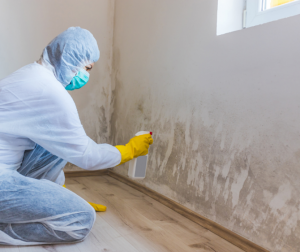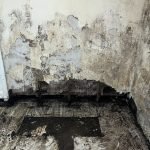
Early Signs of Mold in a House
Mold growth can occur in any home, regardless of how clean or well-maintained it is. The key to avoiding health hazards associated with mold is recognizing the early signs of mold in a house and then taking action quickly. Here, we will get into detail with some common warning signs that may indicate the presence of mold in your home and how to detect it. But first, you will need to know what mold looks like and how to find hidden mold in your house.
What Does House Mold Look Like?
House mold can appear in a range of colors, including black, green, gray, white and more. It can be slimy or fuzzy in texture, and it often has a musty or stale odor.
How to Detect Mold in Your House
Mold can grow in any damp environment, making it a common problem in many homes. Not only is mold unsightly, but it can also have serious health implications, so it is important to detect and address mold growth as soon as possible. Here are ten early signs to look for when trying to identify mold in your home.
Warning Signs of Mold in Your House:
- AC Unit Smells
- Area between Shower Tiles is Dark
- Wallpaper Peeling or Warped
- Rotten Smell
- Contaminated Carpet
- Leaky Water Heater
- Allergy Flare Ups
- You Feel Itchy
- Recently Dealt with Water Damage
- Gunk on Bathroom Tiles
Check Your AC Unit if it Smells
A musty or stale odor can indicate that mold is growing in your air conditioning unit. This is a common problem in homes with central air conditioning systems, as the moist air from inside your home can provide the perfect environment for mold to grow. If you notice an unpleasant odor coming from your AC unit, it is important to have it inspected and cleaned by a professional to prevent the spread of mold.
While inspecting the smell, check to and see if there are black, fuzzy spots on the filter. This could be black mold. Make sure you regularly clean the unit and replace the filters to starve existing mold of its two food sources: moisture and dust.
Check to see if the Area between Your Shower Tiles is Dark
Dark areas or discoloration on the grout between shower tiles can indicate mold growth. This is because the moist environment in the shower provides the perfect conditions for mold to grow and spread. If you notice dark areas or discoloration in your shower, it is important to clean the tiles and grout thoroughly to remove any mold and prevent it from growing back.
To keep your bathtub and walls from becoming discolored, make sure to use a squeegee after each shower or bath. It’s also important not to let wet towels and clothes linger in the hamper for too long – dispose of them as soon as possible. Be mindful of any signs that indicate the shower curtain needs cleaning, such as discoloration.
Your Wallpaper is Peeling or is Warped

Signs of Mold on Walls
If your wallpaper is peeling or has dark spots, it can be a sign that there is mold growing behind it. This is because mold thrives in damp environments, and the moisture from a leak or high humidity can cause wallpaper to peel and eventually lead to mold growth.
If you notice peeling wallpaper in your home, it is important to have the wall inspected for mold and to repair any leaks or dampness issues. Identify the source of the moisture, like a nearby leaky windowsill, and fix the problem before it breeds mold.
There’s a Rotten Smell
A rotten or musty smell can be an early sign of mold in a home. Mold releases an unpleasant odor as it grows and spreads, and this odor can often be detected before the mold itself is visible. If you notice a strong, musty odor in your home, it is important to locate and address the source of the odor before it spreads to other parts of your home.
You Have Contaminated Carpets
Carpets that are contaminated with mold can be a health hazard. Mold can grow in the fibers of carpets that are exposed to moisture, and this can result in a musty odor and other health issues.
Carefully inspect the carpet for any spots, odors, and stains. If something appears unusual to you, make sure to investigate both sides of the carpet and padding.
Check your Water Heater
Any area in the home that is prone to moisture, such as the water heater closet, is a prime location for mold growth. The moisture and warmth created by the water heater provides the ideal conditions for mold to thrive. However, because water heaters are often located in hard-to-reach areas of the home, leaks from the tank can be difficult to detect and may go unnoticed for some time.
To prevent mold growth from a leaky water tank, it is important to regularly check the area around the water heater for signs of condensation on the floor and walls. If condensation is present, this could indicate a leak, and it is important to address the issue promptly to prevent mold growth and potential health problems.
Allergy Flare-Ups
Frequent allergy symptoms could indicate the presence an early sign of mold in your house. Mold growth can lead to a variety of symptoms, including sneezing, a runny nose, and itchy eyes, and it is crucial to promptly address mold to avoid getting sick or any further health issues.
You Feel Itchy
Itching or skin irritation can be a sign of mold exposure. If you or someone in your home is experiencing skin irritation or itching, it is important to locate and address any mold growth in your home to prevent further exposure and health issues.
You Recently Dealt with Water Damage
Have you experienced a water damage event such as flooding from a sink, toilet, or a burst pipe in your home? If the water was not effectively and thoroughly removed, mold growth may have resulted.
Fungus thrives in moist environments, and water damage can quickly result in mold growth, which can cause both structural damage to your home and costly repairs.
Gunk on Bathroom Tiles
A buildup of gunk on bathroom tiles can also be an early sign of mold growth in a house. This is because mold thrives in moist environments, and the moisture from showers and baths can provide the perfect conditions for mold to grow on bathroom tiles. If you notice a buildup of gunk on your bathroom tiles, it is important to clean the tiles thoroughly and to address any underlying moisture issues to prevent mold from growing back.
How to Find Hidden Mold in Your House
Mold tends to thrive in warm, humid environments and can be hard to spot in your home. It is important for homeowners to look for signs of unknown mold growth in order to prevent the spread of airborne mold spores. Careful inspection should be done on all exterior walls for any discolorations or water build-up, especially around door and window frames. By learning how to identify and address hidden mold, you can protect your health and preserve the integrity of your home.
- Check Moisture-prone Areas: Inspect areas prone to moisture accumulation such as bathrooms, kitchens, basements, and around windows for any signs of mold growth.
- Use Your Nose: Mold often produces a musty odor, so follow your nose to detect any unusual smells in different areas of your home.
- Look for Water Damage: Check for any visible signs of water damage such as discoloration, peeling paint, or water stains on walls, ceilings, and floors, as these can indicate hidden mold.
- Inspect Behind Furniture and Appliances: Move furniture, appliances, and other items away from walls to inspect for mold growth, especially in areas where condensation or leaks may occur.
- Check Inside Cabinets and Closets: Mold can thrive in dark, enclosed spaces, so don’t forget to inspect inside cabinets, closets, and storage areas for any signs of mold growth.
- Examine Air Vents and Ducts: Mold spores can spread through your home via HVAC systems, so inspect air vents, ducts, and filters for any signs of mold growth or musty odors.
- Inspect Attics and Crawl Spaces: These areas are often overlooked but can harbor mold growth due to poor ventilation or leaks, so be sure to inspect them thoroughly.
- Use a Flashlight: Mold can hide in dark corners and crevices, so use a flashlight to illuminate hard-to-reach areas such as behind pipes, under sinks, and in crawl spaces.
- Consider Hiring a Professional: If you suspect mold but are unable to locate it, consider hiring a professional mold inspector who has the tools and expertise to detect hidden mold in your home.
- Monitor Humidity Levels: Keep an eye on indoor humidity levels using a hygrometer and take steps to keep them below 60% to discourage mold growth.
If you suspect an area has mold growth but cannot see it, a musty odor is a strong indication there could be hidden moisture causing the unwelcome visitors. The problem should be pinpointed and fixed as soon as possible to limit the spread of hazardous mold spores which can have serious long-term effects on health.
Think you Have some Early Signs of Mold in your Home?
Mold growth in the home can have serious health implications, so it is important to detect and address it as soon as possible. If you suspect some early signs of mold growth, it is important to have it inspected by a professional to determine the type and extent of the mold, and to implement a plan for removing it and preventing it from growing back. By being vigilant and looking for signs of mold growth, you can take steps to protect your health and keep your house free of mold.
[otw_shortcode_button href=”/request-help/” size=”medium” icon_position=”left” shape=”square”]Get Professional Mold Removal and Remediation help today![/otw_shortcode_button]




